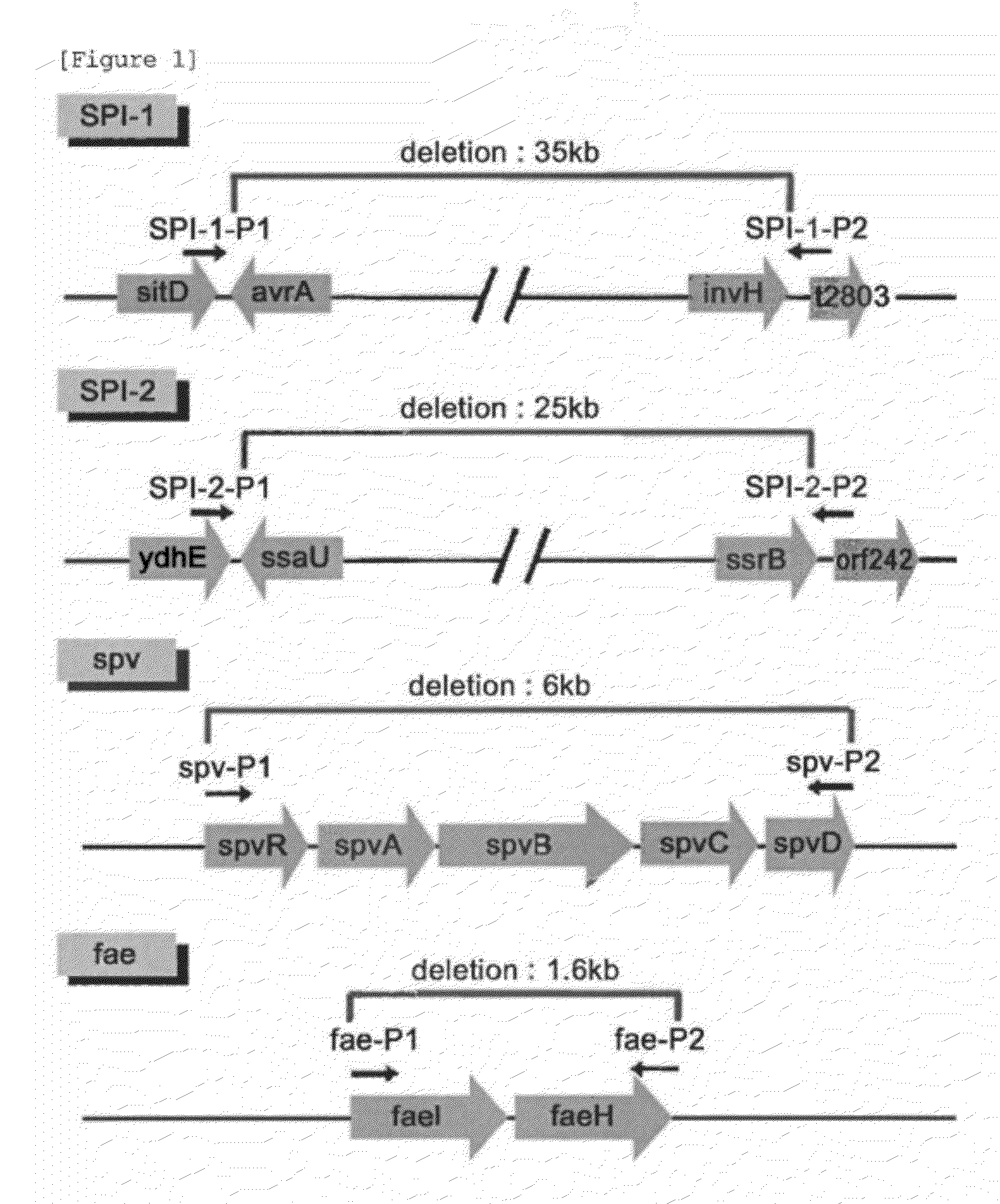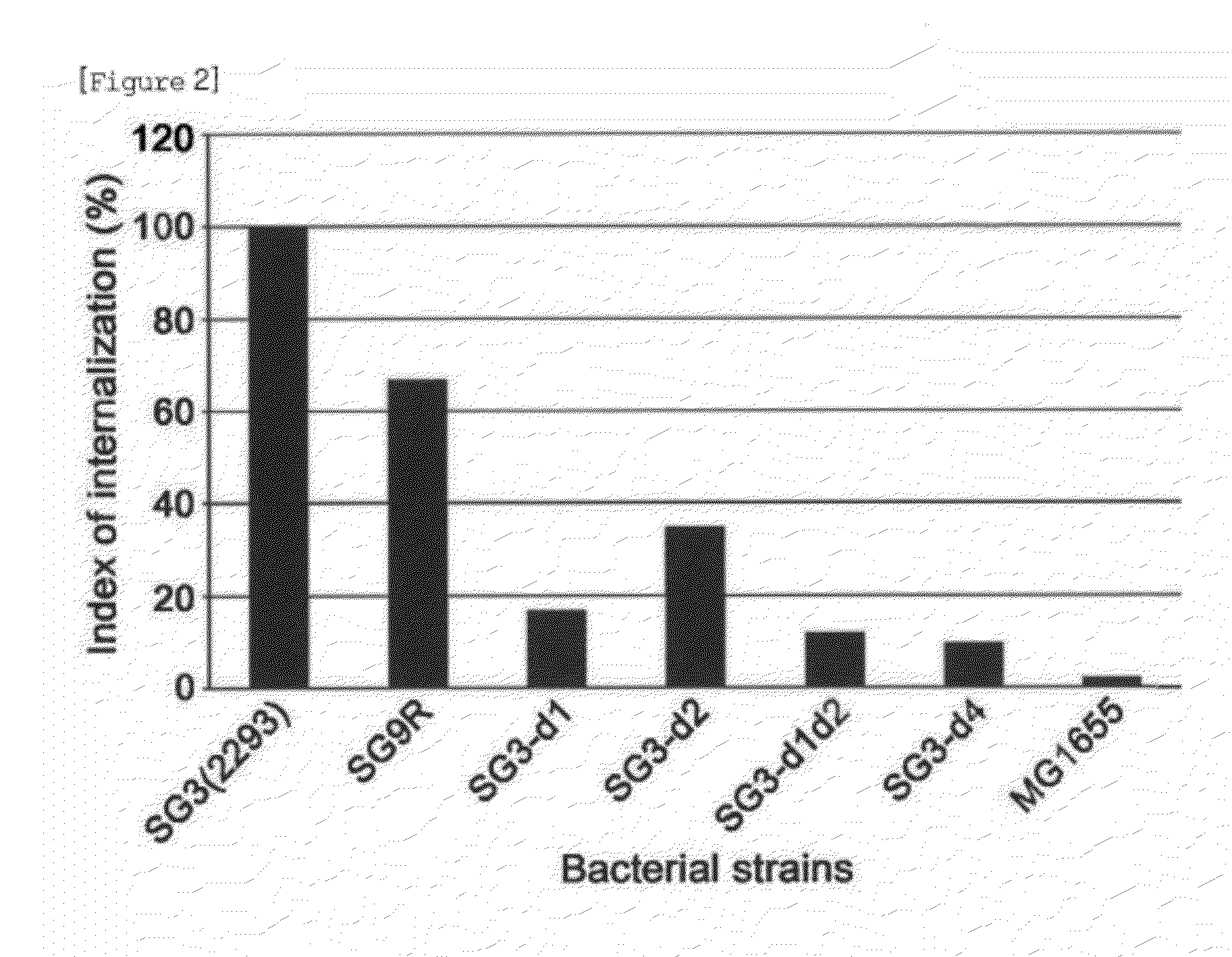Avirulent Salmonella Gallinarum Variants and Pharmaceutical Composition Using the Same
a technology of salmonella gallinarum and pharmaceutical composition, which is applied in the field of avirulent salmonella variants, to achieve the effect of significant added value and high industrial utility valu
- Summary
- Abstract
- Description
- Claims
- Application Information
AI Technical Summary
Benefits of technology
Problems solved by technology
Method used
Image
Examples
example 1
Screening of Target Genes to be Inactivated Through Comparison of Salmonella Gallinarum Virulence Genes
[0050]The first step of preparing avirulent avian Salmonella strains was the screening of target virulence genes to be inactivated. Salmonella Pathogenicity Island-1 (SPI-1), and Salmonella Pathogenicity Island-2 (SPI-2), both of which are type three secretion system gene clusters essential for the delivery of the pathogenicity of Salmonella, and spvRABCD and faeHI, both of which are genes on virulence plasmids, were determined as target genes, and the data base of the NCBI was searched for the nucleotide sequences of the target genes (Salmonella enterica subsp. enterica serovar Gallinarum str. 287 / 91, NC 011274). Because the nucleotide sequence of spvRABCD of Salmonella Gallinarum had not yet been disclosed, primers were synthesized with reference to the nucleotide sequence of the same name gene of Salmonella typhimurium (Salmonella typhimurium LT2 plasmid pSLT, NC 003277), which ...
example 2
Preparation of Avirulent Variants by Inactivation of Virulence Genes of Salmonella Gallinarum and by Integration of the Inactivated Sites
[0051]2-1. Inactivation of Virulence Genes of Salmonella Gallinarum
[0052]To delete TTSS-related virulence genes of the wild-type Salmonella Gallinarum (SGSC No. 2293) as determined in Example 1, the one-step deletion method using lamda Red recombinase, developed by Datsenko K A et al., (Datsenko K A et al, PNAS, (2000);97(12):6640-6645), was employed.
[0053]A chloramphenicol resistant gene of pKD3 was used as an antibiotic marker for identifying insertion into a target site of chromosome. Using a pair of the primers SPI-1-P1 (SEQ ID NO: 5) and SPI-1-P2 (SEQ ID NO: 6) of Table 1, which correspond to 50 bp of 5′ flanking region of the avrA and 50 bp of 3′ flanking region of the invH gene, wherein SPI-1 comprising from avrA to invH is target for deletion, and a part of the chloramphenicol resistant gene of pKD3, respectively, a polymerase chain reacti...
example 3
Assay of Virulence Gene-Inactivated Salmonella Gallinarum SG2-d4 for Avirulence by Measurement of Invasion Efficiency into Avian Epithelial Cell
[0070]Salmonella Gallinarum and Salmonella pullorum, which are unique Salmonella species due to the lack of a motile flagella, are specifically infected to avian cells and can invade other animal cells but at very low efficiency. In this example, an in vitro cell invasion assay was conducted (Henderson S C et al, Infect Immun, (1999); 67(7):3580-3586) on the avian epithelial cell line BAT (Budgerigar Abdominal Tumor), provided from MD. Lee, Georgia University. The avirulent Salmonella Gallinarum variants SG3-d1d2 and SG3-d4, developed by the above-described gene deletion method, were expected to invade the host cell with very low efficiency by reduced level of TTSS-related protein. A recent research review on the infection mechanisms of pathogenic microorganisms has it that even when only a specific gene of SPI-1 is deleted, the Salmonella s...
PUM
| Property | Measurement | Unit |
|---|---|---|
| frequency | aaaaa | aaaaa |
| concentration | aaaaa | aaaaa |
| mass scale | aaaaa | aaaaa |
Abstract
Description
Claims
Application Information
 Login to View More
Login to View More - R&D
- Intellectual Property
- Life Sciences
- Materials
- Tech Scout
- Unparalleled Data Quality
- Higher Quality Content
- 60% Fewer Hallucinations
Browse by: Latest US Patents, China's latest patents, Technical Efficacy Thesaurus, Application Domain, Technology Topic, Popular Technical Reports.
© 2025 PatSnap. All rights reserved.Legal|Privacy policy|Modern Slavery Act Transparency Statement|Sitemap|About US| Contact US: help@patsnap.com


